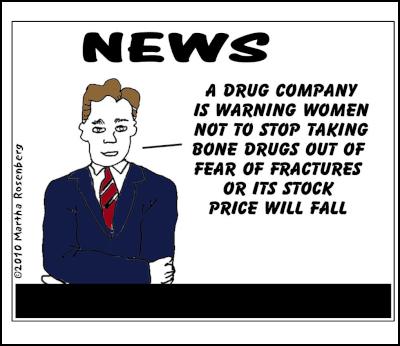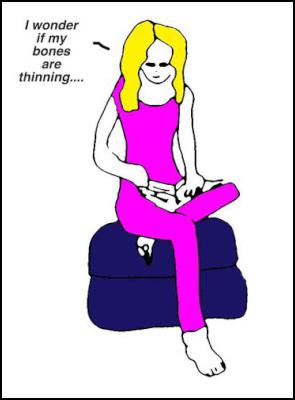Were Bone Scans Bone Scams?
Were Bone Scans Bone Scams?
By
Martha Rosenberg
February 23,
2012
Women are in such danger of osteoporosis they need regular bone scans. That was conventional medical "wisdom" since the first lucrative bone drug surfaced over a decade ago. But a recent article in New England Journal of Medicine reveals that the warnings don't apply to 90 percent of women who have been getting the scans--and the bone drugs the scans were designed to sell--for no reason. How did this happen?
In 1994, a year before Fosamax, Merck's blockbuster bone drug, was approved, Merck began marketing the dangers of osteoporosis "far beyond ailing old ladies." It hired researcher Jeremy Allen to whip up osteopenia fears to sell bone drugs by planting bone scan machines in medical offices across the country, says National Public Radio. Allen created the faux "Bone Measurement Institute" to establish osteopenia, the "risk of osteoporosis," as a health epidemic. The scheme worked. By 1999, there were 10,000 bone scan machines in medical offices, said the Associated Press, when there had been only 750 before the bone drugs hit the market. The diagnosis of osteopenia increased seven fold.
Allen's company also pushed through the Bone Mass Measurement Act which made bone scans Medicare reimbursable. The legislation was written by Rep. Constance A. Morella (R-MD.), who appeared with HHS Secretary Donna Shalala in 1998 at a rally kicking off free bone density screenings to be offered in US 100 cities. Not that they had a opinion. The publicly funded bone scans were so lucrative to drug companies, when their Medicare-reimbursement became threatened, an article in the Cleveland Clinic Journal of Medicine article exhorted readers to "Lobby your legislators," scientific objectivity be damned.
The article, "Managing Osteoporosis: Challenges and Strategies," (PDF) says without Medicare reimbursement, patients are "likely to be harmed by limited access to DXA testing [bone scans] because of fewer instruments in operation and greater distances to travel to reach them," and outpatient facilities will incur "financial losses."
While osteoporosis is a real disease, osteopenia was never meant to be "a disease in itself to be treated," says Dartmouth Medical School professor Anna Tosteson, MD who attended the 1992 World Health Organization (WHO) meeting in Rome where the term was first invented. The scientists in the room were simply tired and agreed on a definition of the term because they wanted to adjourn for the night, she told NPR.
The bone density units, called "T scores," used to define osteopenia are equally as fallacious, wrote Susan Kelleher in Seattle Times: They had "boundaries so broad they include more than half of all women over 50."
If bone drugs like Fosamax, Boniva and Actonel (called bisphosphonates) weren't harmful, the bone scan con would simply be a case of overmedicating women, ripping off patients, taxpayers and raising insurance costs. But bisphosphonates have been reported to greatly increase the risk of esophageal cancer and osteonecrosis of the jaw--jawbone death. Some dentists will not work on women who take them. Bisphosphonates are also linked to irregular heart beats and intractable pain, according to medical journals and FDA warnings.
Nor do the bone drugs even prevent fractures--their intended purpose! By suppressing bone remodeling, they are supposed to stop bone loss. But since the bone is not being renewed, it becomes brittle, ossified and fractures. The thigh bones of patients on bisphosphonates have "simply snapped while they were walking or standing," after "weeks or months of unexplained aching," reported the New York Times in an article called "Drugs to Build Bones May Weaken Them." Oops. Medical journals and patients on the web site askapatient have been reporting the fractures for years.
At the 2010 American Academy of Orthopaedic Surgeons annual meeting in New Orleans, doctors were actually shown the qualitative differences in bisphosphonate treated bone and could see how the bone had degraded over four years of treatment. Half the doctors at one presentation said they'd seen patients with bisphosphonate- compromised bone personally, when asked, reported the Los Angeles Times.
It should be embarrassing to the medical establishment and Medicare administrators that the drug industry and its paid celebrities drove the mania for the bone scans, "osteopenia" and bone drugs. Look how Today host Meredith Vieira helped.
"When I became menopausal, my doctor recommended I get a bone mineral density test. I had never even heard of it, to be quite honest. I thought, 'I'm in great health, great shape. I have no symptoms. Why do I need this?'" she told USA Today. "To illustrate how ignorant I was when I had the test done, I asked where I could change and the nurse told me I didn't need to take off my clothes. They did a test on my heel, hip and spine, which only took a matter of five minutes. And it was totally painless. It's so simple to do."
And it should be even more embarrassing that the con only surfaced when the biggest bone drug patents are expired so the drug companies don't even care--because the big bucks are behind them.
Martha Rosenberg's first book, Born With a Junk Food Deficiency: How Flaks, Quacks, and Hacks Pimp the Public Health, will be published in April by Prometheus Books.




 Eugene Doyle: Quiet Mutiny - The U.S. Army Falls Apart
Eugene Doyle: Quiet Mutiny - The U.S. Army Falls Apart Gordon Campbell: Papal Picks, And India As A Defence Ally
Gordon Campbell: Papal Picks, And India As A Defence Ally Binoy Kampmark: The Selling Of America - Ending The US Dollar’s Exorbitant Privilege
Binoy Kampmark: The Selling Of America - Ending The US Dollar’s Exorbitant Privilege Frances Palmer: Remembering Vietnam And Cambodia 50 Years On During ANZAC Week
Frances Palmer: Remembering Vietnam And Cambodia 50 Years On During ANZAC Week Binoy Kampmark: Euphemistic Practices - The IDF, Killing Aid Workers And Self-Investigation
Binoy Kampmark: Euphemistic Practices - The IDF, Killing Aid Workers And Self-Investigation Gordon Campbell: On The Left’s Electability Crisis, And The Abundance Ecotopia
Gordon Campbell: On The Left’s Electability Crisis, And The Abundance Ecotopia